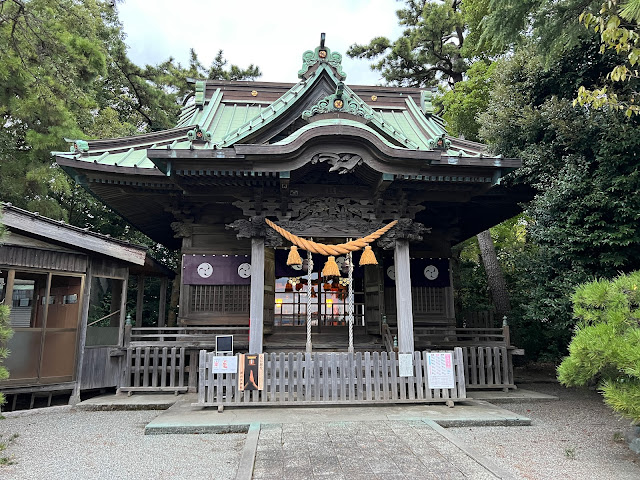I’d gone to bed catatonically tired the previous night and nervous about the prospect of the next day’s walk. In the event, although I covered almost the same distance I found it less exhausting and went to bed in good spirits. A better night’s sleep may have helped.
After breakfast at a station cafe, I caught the train back to Totsuka and picked up the route. The weather was as overcast as the day before, but cooler and breezier and with no drizzle, and less humid. Good conditions for walking.
Things did not begin auspiciously, however. Stopping to pay my respects at the first roadside shrine, I nodded a greeting to the woman tending the grounds just inside the torii gate. My first 5 yen offering bounced off the grating of the box and disappeared behind. Rather than grovel about on the ground trying to find it, I fished out another coin and more carefully lobbed it in. Ring the bell, bow twice, clap twice, pause for prayer/reflection/whatever, bow once, clap once… It was only as I turned and headed back through the torii gate that I realised with horror that I’d forgotten to wash at the chozuya, which the woman – no doubt appalled by my behaviour – was now cleaning, as if to emphasise my indiscretion. I vowed to visit another shrine later in the day and do things correctly to try to make up for this error.
A couple of kilometres on from Totsuka station, the Old Tokaido began a long but gentle climb, eventually joining the very busy National Route 1 at a ridge line with views of hills to the west and a line of ‘mansions’: freestanding apartment blocks, often named in English and for some reason usually in Gothic script.
A nearby signboard mentioned views of Mount Fuji, but on this day of low-hanging clouds there was little prospect of that.
I realised that roadside poles marked off the distance from point zero – Nihonbashi (or Nihombashi: the Romanisations seem to be interchangeable) – which I appreciated as a reminder of how far I’d come.
There’s little to say about this section of the day’s walk. Hills to the right in the distance, backed-up traffic on the road and a gentle slope down. Eventually the new road bore right away from the Old Tokaido, and a quieter and steeper stretch headed down towards Fujisawa.
A signboard noted the former presence of an ichirizuka.
At the bottom of the hill the old road turned right, skirting the modern town centre, past the entrance to a large temple where some sort of event was taking place (I regret not stopping to investigate)…
… and over a bridge that some effort had been made to construct in an older style.
By now it felt like time for coffee and a break, and Garage Cafe 0828 seemed likely to offer both. Two gentleman occupied the tiny space’s only table, so I took a seat at the counter and studied the menu – none of which I could read. Noticing that one of customers was drinking what looked like a cappuccino or flat white, I asked as politely as I could what he was drinking. Cafe au lait, of course, which I was assured was delicious. So that was what I ordered, and it did not disappoint. Meanwhile I noticed a couple of American jazz posters on the walls, and the owner put on a really cool hard bop CD from (I’d guess the 50s or 60s).
As I stood to leave and gathered my things, the customer who’d been drinking the cafe au lait asked in English what my ‘course’ was. It took a moment to realise he was asking where I was walking to, so rather than trying to explain I showed him my introduction on my phone, which he read aloud for the benefit of the others. Much appreciation for my undertaking was expressed. Again, conversation was limited, but we managed to talk about the fact that the weather was good for walking and that the section of the route after Odawarra – up to Hakone checkpoint – would be very different from what I was currently experiencing. I asked if I could take a photograph and, like my friend from the day before, they were gracious enough to agree.
The man in the middle is the owner. If you’re ever in Fujisawa, pop in to Garage Cafe 0828 and say hi. Great coffee and great music.
Like the previous days, today’s walk would not win any awards for scenic beauty. There were, however, some nice houses and gardens along the way…
… and an odd little roadside shrine…
Near Chigasaki, the road is lined with pines, which I believe are a typical feature of the Old Tokaido.
As the light, never intense on this entirely overcast day, started fading, I passed a particularly beautiful shrine and took the opportunity to make up for my earlier faux pas. The photo doesn’t do justice to the place. This time I was careful to maintain etiquette and felt, absurdly, that a wrong had been rectified. No one, I think, was there to see my little ceremony, but as I left a man entered beneath the torii gate and made his way briskly towards the shrine. We nodded as we passed.
Eventually I reached the long Banyu Bridge over the Sagamigawa in the gathering gloom (‘gawa’ I think means river, so Sagamigawa River means ‘Sagami River River’), the lights of Hiratsuka on the other side and my second big river crossing. Once across, a kilometre or so further on and a left turn took me to the railway station and a train back to Odawara and my hotel.
(PS: Apologies for the formatting of these posts. Blogger does not seem to play nicely with this iPad.)














Comments
Post a Comment